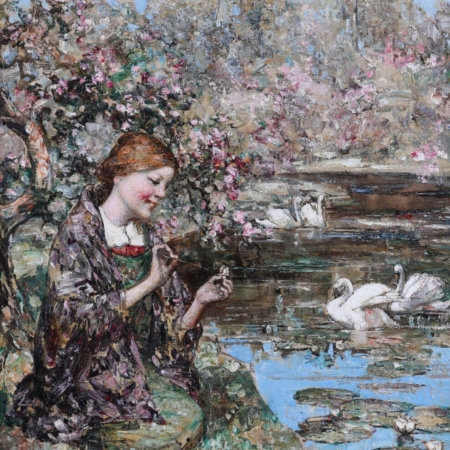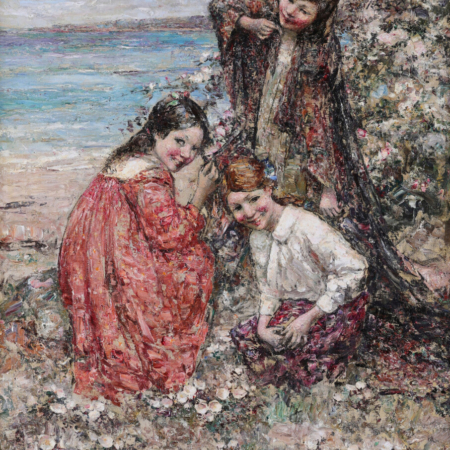
Edward Atkinson Hornel
Edward Atkinson Hornel was a Scottish painter of landscapes, flowers, and foliage, with children. He was a cousin of James Hornell.
He was born in Bacchus Marsh, Victoria, Australia on 11th July, 1864 to Scottish parents. The Hornel family then moved to Kirkcudbright, Scotland where Edward spent his childhood. . Between 1881 and 1883 he studied art at the Trustees Academy in Edinburgh and continued his training under Verlat in Antwerp. The works of the early period show a strong Belgian influence; mostly landscapes with figures in the manner of Maris or Mauve. Returning from Antwerp in 1885, he met George Henry and associated himself with the Glasgow School. Through this friendship Hornel moved to a more colourful, decorative and increasingly symbolic style. Indeed their ten-year long association produced a series of pictures that are regarded as the essence of the Glasgow School. Using low-keyed palettes, Henry and Hornel tried to escape subject and local colour, concentrating on purely decorative colour arrangements.
Hornel and Henry collaborated upon “The Druids Bringing in the Mistletoe” (1890), a procession of priests bringing in the sacred mistletoe, gorgeous with polychrome and gold. The two worked side by side to achieve decorative splendor of color, Hornel boldly and freely employing texture effects produced by loading and scraping, roughening, smoothing, and staining, where Hornel learned much about decorative design and spacing. In 1893 Hornel and George Henry visited Japan, funded by among others, the picture dealer Alexander Reid and the Glasgow collector and ship-owner William Burrell. The two artists arrived in Nagasaki in late April, a beautiful time of the year to be introduced to Japan, with the last snow still on the ground and the plum trees laden with blossom. The artists based themselves in Tokyo and although they had wanted to experience Japanese life, government regulations restricted their meeting with local people. However in the grounds of Ueno park and nearby Asakusa, Hornel was able to interact with families enjoying the sunshine; “I associate and love to remember them, as a large and happy family, clattering along in the sunshine with smiling faces and no thought of the morrow, to spend the day ‘mid plum and cherry blossom, or at night joyous and elevated with saki, amusing themselves with pretty geishas, dancing to the weird music.” He appreciated the Japanese reverence for nature (‘Nature to them is symbolism itself’) and their festival times (‘the whole earth [rejoices] in a profusion of bloom’) but what emerged most powerfully from this account was an obsession with good and bad taste, with charm and vulgarity – the charm and perfect taste displayed in Japanese flower arranging, the vulgarity and bad taste of the West. Hornel hankered after the ‘highest ideals of the Feudal Jap of old time’, for the present day merchant classes are ‘liars and untrustworthy’. This class and cultural snobbery extended to his perceptions of Japanese gardens. He admired the ‘gardens of the wealthy and upper classes where miniature lakes and waterfalls with quaint bridges, tiny landscapes with dwarf pines and shrubs relieved with stone lanterns, take you into fairyland’. To Hornel the Japanese aesthetic was ‘the greatest impressionism the world has so far possessed – all useless details are laid aside’. ‘All Orientals are more or less possessed of this intuitive sense of balance even the ‘common man’ has acquired the scientific placing of his things the feeling permeates all classes’
Hornel was fascinated by the tea ceremonies, the beautiful dancing, the elegance of the young women and their vibrant costumes. The paintings he produced in Japan reflect his enthusiasm for the country and its people. The body of work which Hornel produced during this short period contains some of his most interesting and beautiful pictures.
His later work lacked the vitality of his Japanese paintings, becoming increasingly formulaic, as epitomised by his popular scenes of young children playing amongst flowers which he reworked in numerous variations. It is for these later works that he is still chiefly remembered while the early work which placed him at the very forefront of progressive painting in Scotland and did much to earn Scottish art international acclaim, is now largely forgotten.Hornel also visited Ceylon and Australia in 1907 and Burma, Canada and America between 1920-1921.
Hornel exhibited for the first time in 1883 at the Edinburgh Exhibition. He became a member of the International Society of Painters and Engravers and an associate member of the New Gallery. In 1901 Hornel was elected to the Royal Scottish Academy but declined the honour.I
n 1901 he acquired Broughton House, a townhouse and garden in Kirkcudbright, which was his main residence for the rest of his life. On his death the house and library were donated for the benefit of the citizens and Broughton House is now administered by the National Trust for Scotland.
There are examples of his works in the museums of Aberdeen, Buffalo, St. Louis, Toronto, Montreal, Glasgow, Edinburgh, Leeds, Manchester, Hull, Bath, and Liverpool.
Click on the images below to view and purchase our paintings by Edward Hornel…
- Display 24 Products per page


